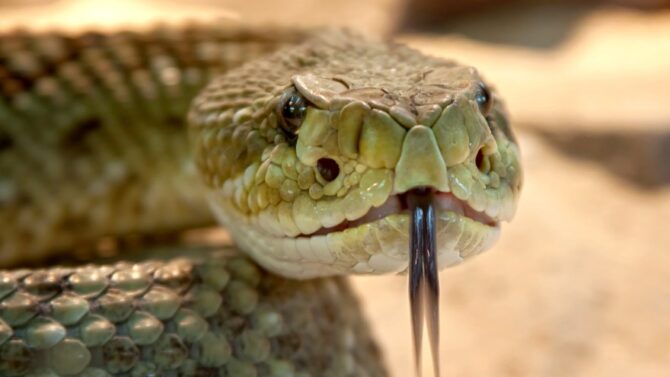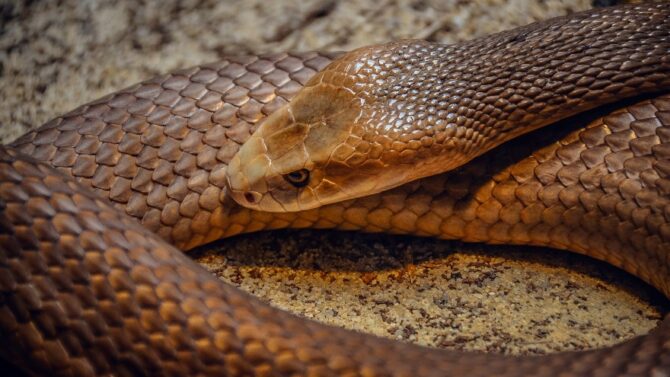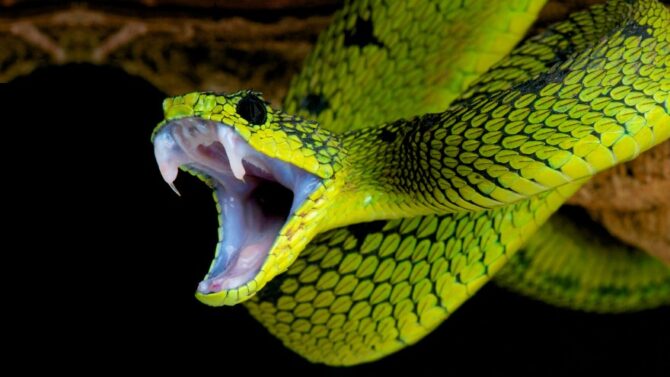Snakes can be of different colors based on their adapted environment for survival.
While some snake colors can be green, brown, black, yellow, etc., others can be multicolored.
Purple snakes are among the rarest, and a few species may have full or partial purple coloring. One common example is the lavender corn snake that comes with purple coloring.
Examples of Real Purple Snakes
1. Cape File Snake

- Scientific Name: Limaformosa capensis
- Common Name: Cape file snake
- Size: 4.9 feet (length)
- Lifespan: 15 – 20 years
Cape file snakes are native to South Africa but can also be found within a large geographic range all over Africa, residing in coastal forests and savannas.
These species are medium to large-sized and are commonly found in gray colors with brown or purple markings in some cases, giving them an appealing look.
Their purple coloring is seen very clearly in between their scales.
2. Western Blind Snake
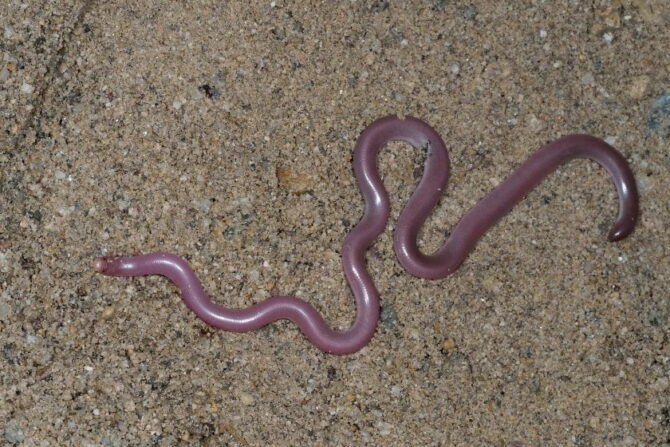
- Scientific Name: Rena Humilis
- Common Name: Western worm snake, western slender blind snake
- Size: 6 to 12 inches (length), 0.05 ounces (weight)
This species is tiny and slim, making it look more like an extra-long worm, and just like its name, it is a blind snake.
The western blind snake ranges in the arid lands of New Mexico, Southern California, Arizona, and Baja California.
Because it resides underground where the soil is damp and doesn’t need eyes, it seems to have lost its sense of sight. It usually comes in pink or purple color.
3. Western Hognose Snake
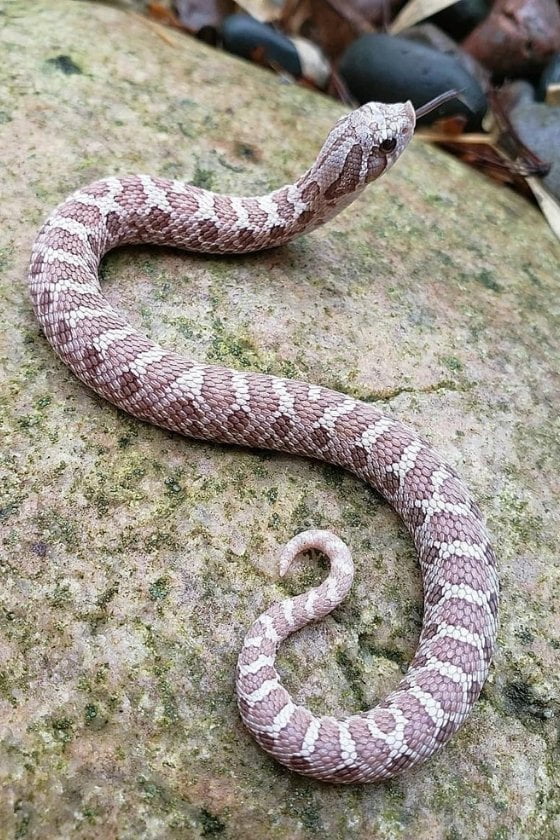
- Scientific Name: Heterodon nasicus
- Common Name: Hognose
- Size: 15–20 inches (length), 0.5 pounds (weight)
- Lifespan: 10 to 20 years
Western Hognose are small species with upturned scales at the tip of their snout to dig for food and burrow.
Hognose are natives in the central United States and east of the Rockies.
People can take western hognoses as pets due to their adorableness and dramatic behavior of playing dead.
This species has several beautiful morphs, including the lavender morph, which has a lighter lavender base with darker purple blotches throughout its entire length.
4. California Kingsnake (Purple Passion Morph)

- Scientific Name: Lampropeltis California
- Common Name: Kingsnake, Cali kings
- Size: 4 to 5 feet (length), 0.9 to 3.3 pounds (weight)
- Lifespan: 15 to 20 years
This snake species is native to the west coast of North America but can be found in almost every part of the world because people usually keep it as a pet.
It has many morphs and wide color variations, one of which is the beautiful purple passion morph.
This morph has a purple base with white bands all through its body. Also, the ghost morph is pink with purple hints.
Also See: King Snake Vs Corn Snake: 6 Differences & Similarities
5. Ball Python (Purple Passion Morph)
- Scientific Name: Python regius
- Common Name: Ball python, purple passion
- Size: 4 to 5 feet (length), 3 to 5 pounds (weight)
- Lifespan: 20 to 30 years
The ball python is one of the most common pet snakes because it is pretty, and biologists and snake breeders have made many colored morphs.
There are estimated to be about 4,000 ball python morphs, including the purple passion morph, created from breeding a Mojave and a phantom morph.
This purple morph has dark black or brown eyes with a creamy purple base color and a white stripe along the length of its spine.
6. Banded Rock Rattlesnake
- Scientific Name: Crotalus lepidus
- Common Name: Green rattlesnake, green rock rattlesnake
- Size: 25 to 30 inches (length), 2 to 10 pounds (weight)
- Lifespan: 10 to 20 years
The banded rock rattlesnake species is native to some parts of the Southern United States and Mexico.
It is light gray with darker gray to purple bands along its entire body length.
This snake’s color depends on subspecies and geographic location. The banded rock rattlesnake is a nocturnal snake that hides away during the day.
7. Corn Snake
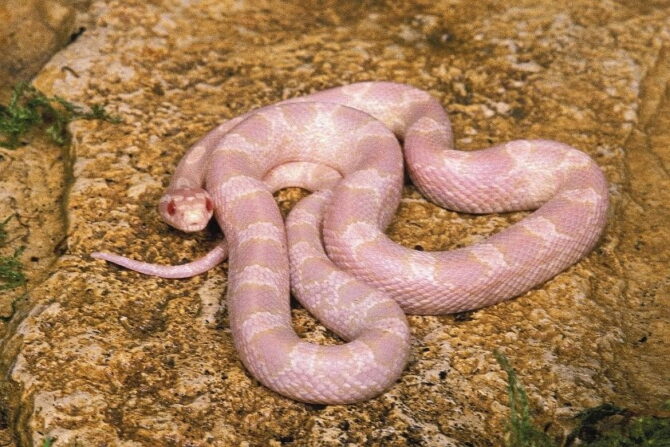
- Scientific Name: Pantherophis guttatus
- Common Name: American corn snake
- Size: 4 to 6 feet (length), 1.6 to 2 pounds (weight)
- Lifespan: Up to 20 years
The corn snake is another popular snake with purple-colored morphs. It got its name from its history of preying on rodents trying to eat corn in grain stores.
Corn shakes are great climbers with a wide variety of colors and patterns, but not all are pretty.
A beauty among them is the lavender corn snake; it has striking red eyes and a grayish-white base with a pinkish purple pattern.
Other corn snake morphs like opal and plasma corn snakes also have partial purple coloring.
8. Reticulated Python (Lavender Albino Morph)
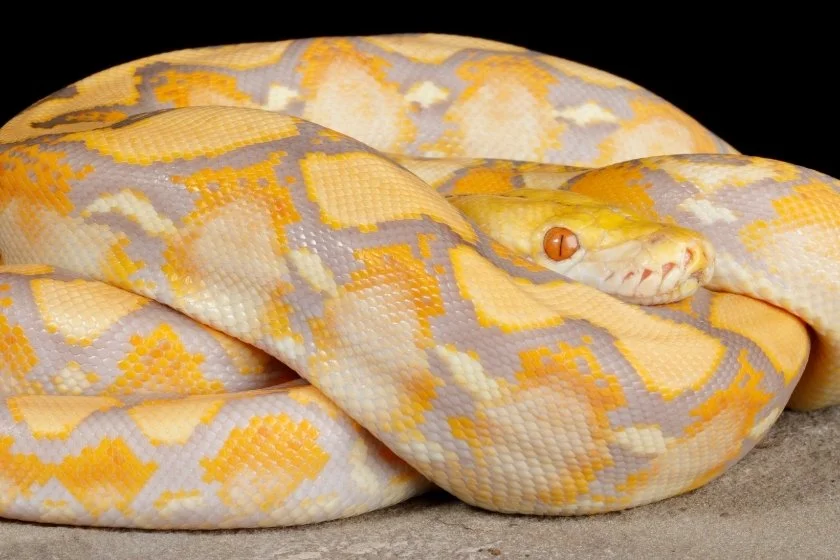
- Scientific Name: Malayopython reticulatus
- Common Name: Reticulated python, retics
- Size: 12 to 16 feet (length), 150 pounds (weight)
- Lifespan: 12 to 20 years
The reticulated python can grow more than 16 feet, making it the longest snake in the world and weighing over 150 pounds.
It resides in Asia, and while it has lovely coloring, there are also attractive morphs.
Its lavender albino morph has a light purple base and orange markings on its body.
Reticulated pythons are among the smartest snakes in the world; the ones kept as pets can identify their keeper and remember their experience with people.
9. Neotropical Snail Eater
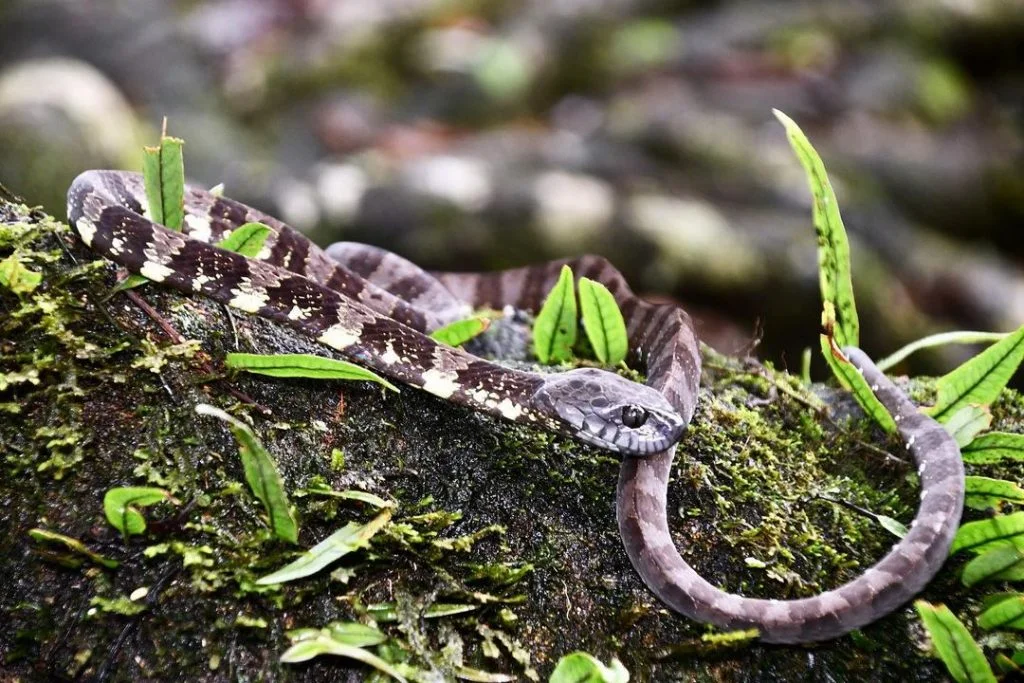
- Scientific Name: Dipsas indica
- Common Name: Amazonian snail eater, Big-headed snail-eating snake
- Size: 1.5 to 2.5 feet (length)
- Lifespan: 8 to 10 years
Snail-eaters are generally small with slim bodies and very large heads.
These species are found in Southern America and get their name from feeding on snails and slugs.
Most snakes typically have gray bodies with blackish-yellow patches, but people have seen some with purple scars on their bodies.
These species are active at night on trees in forests and plantations.
10. Mangrove Pit Viper

- Scientific Name: Trimeresurus purpureomaculatus
- Common Name: shore pit viper, mangrove viper, purple-spotted pit viper
- Size: 13 feet (length), 15 pounds (weight)
- Lifespan: 9 years
Some people have found these snake species close to water or wet areas.
Pit vipers are extremely vicious and unpredictable, so you should appreciate them from afar to prevent any harm.
Mangrove pit vipers are attractive and come in different colors ranging from olive to gray and purplish brown.
The purple colors are usually very prominent between its scales. They range in Singapore, West Malaysia, Thailand, Indonesia, and Burma.
Frequently Asked Questions
Are Purple Snakes Poisonous?
Most purple snakes aren’t poisonous, and there are no reports of serious complications due to their bites; this is why people have adopted most of the species above as pets.
However, a few of them, like the western blind snake and mangrove pit viper, are venomous and should be avoided.
Purple snakes adopted as pets are believed not to be venomous, but when you come across a one in nature, thread with caution to prevent any harm.
Can pythons be purple?
Yes, purple pythons exist. These are the beautiful purple passion ball python with striking eyes, and they make very good pets.
Conclusion
Purple snakes are not common, but they’re in existence.
Although all-purple snakes are extremely rare, we’ve listed ten real snakes with purple colorings, though the intensity of the color differs.
The purple color is generally attractive, so these species are quite pretty.
Most purple snakes are not poisonous; hence, they can be kept as pets.
Featured Image (c) iNaturalist


